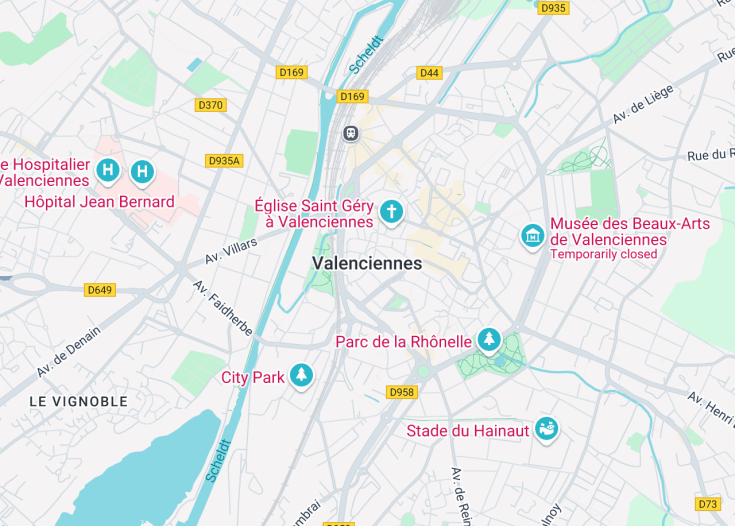Valenciennes, often revered as the “Athens of the North,” is a gem in France’s Hauts-de-France region, notable for its rich artistic heritage and vibrant cultural scene. This picturesque city, with its impressive array of museums, such as the Musée des Beaux-Arts, and historical sites like the Basilique Saint-Cordon, offers a profound glimpse into French art and history. The carefully preserved architecture and the scenic parks provide a tranquil yet enriching experience for travelers seeking both relaxation and intellectual stimulation.
Explore Valenciennes’ vibrant market on Place d’Armes, held on Tuesday and Saturday mornings, to experience local flavors and artisan crafts.
Don’t miss a performance at Le Phénix, the national scene of Valenciennes, which features a diverse range of arts from drama to dance shows.
Top things to do & see in Valenciennes
Select the following sights and activities to discover best tickets and tours available in Valenciennes.
Valenciennes: Gateway to Northern France
| Country | France |
| Time in Valenciennes | GMT+1 |
| Language spoken | French |
| Population | 43,787 (INSEE, 2021) |
| Currency | Euro (€, EUR) |
| Airports |
|
Valenciennes, a historic city in the Hauts-de-France region, boasts a rich cultural heritage and a strategic location near the Belgian border. Known for its art, history, and educational institutions, Valenciennes has played a pivotal role throughout French history from medieval times through the industrial revolution and into the modern era.
Where is Valenciennes?
Located in northern France, Valenciennes is part of the Nord department. It is situated near the Scheldt river, enhancing its scenic charm and historical significance.
Distances:
| Route | Distance by car | Time by car |
|---|---|---|
| Paris to Valenciennes | 130 miles / 210 km | 2 hours 10 mins |
| Lille to Valenciennes | 35 miles / 56 km | 40 mins |
| Brussels to Valenciennes | 74 miles / 119 km | 1 hour 10 mins |
What is Valenciennes famous for?
Valenciennes is distinguished for its artistic legacy, notably the Valenciennes School of Painting which influenced art in France and Belgium from the 15th century forward. It’s also known for its historic buildings and lively cultural scene.
History
Prehistory to Roman Era
The area around Valenciennes, currently known in northern France, shows traces of human activity dating back to prehistoric times. Archaeological finds suggest the presence of early human settlements, indicating a rich and diverse historical tapestry. With the Roman conquest, the region saw significant development, becoming part of the vast Roman Empire. Roman influence brought advancements and a period of prosperity evidenced by the remains of Roman roads and structures.
Medieval Period (5th Century – 15th Century)
Valenciennes began to emerge more distinctly during the medieval period as a small yet strategic town. By the 11th century, it had become an important center due to its position on the trade routes between Flanders and the Hainaut province. Its fortifications were constantly expanded and improved. In 1215, Valenciennes received its town charter, which spurred development and marked its rise as an influential medieval town. This period was characterized by the flourishing of arts and the establishment of several religious institutions.
Early Modern Period (16th Century – 18th Century)
The 16th and 17th centuries were challenging due to various conflicts such as the Eighty Years’ War, which impacted Valenciennes significantly. The town was contested by various European powers, including the Habsburgs and the French. In 1677, Valenciennes was incorporated into France under Louis XIV. The French period initiated industrial growth and increased urban development, leaving a lasting imprint on the city’s architectural and cultural landscape.
Industrial Revolution to Present Day
The 19th century saw Valenciennes transform into an industrial hub, particularly known for its coal mining and metallurgy industries. This era shaped much of the modern cityscape and significantly influenced the local economy. Post World War II, like many European cities, Valenciennes underwent a period of reconstruction and modernization. Today, it’s recognized for its rich cultural heritage, fine arts, and as an educational center, with a focus on integrating its historical legacy with modernity.
Visit Valenciennes
What to see and do in Valenciennes
Valenciennes offers a variety of attractions and activities for visitors. Key highlights include the Musee des Beaux-Arts, which houses an impressive collection of paintings and sculptures. The town’s historical core, with its charming medieval architecture, invites leisurely walks. For a taste of local life, explore the vibrant market places and the scenic public park, Parc de la Rhônelle.
- Musee des Beaux-Arts
- Historic town center
- Parc de la Rhônelle
- Saint-Cordon Festival
- Local artisan markets
Festivals and Events in Valenciennes
Valenciennes hosts a range of cultural and traditional events throughout the year. One of the most significant is the Saint-Cordon Festival, held annually in September, which celebrates the local legend with a grand procession and various festive activities. Other notable events include the Valenciennes Film Festival and numerous art exhibitions, enriching the city’s vibrant cultural scene.
Best time to visit Valenciennes
The best time to visit Valenciennes is during the spring (April to June) and early autumn (September to October). These periods offer mild weather, ideal for exploring outdoor attractions and participating in local events such as the Saint-Cordon Festival.
Is Valenciennes worth visiting?
Valenciennes is certainly worth a visit, particularly for those interested in art and history. The city’s Musee des Beaux-Arts is a cultural gem, and the historical center offers a glimpse into the rich past of the region. While the city is smaller and less bustling compared to major French tourist destinations, its charm lies in its tranquil atmosphere and the friendly locals. However, visitors looking for a vibrant nightlife or extensive shopping opportunities might find it less appealing. Overall, Valenciennes is an excellent destination for a leisurely cultural escape.










